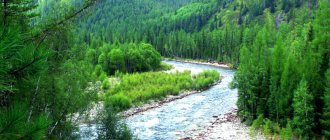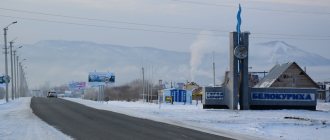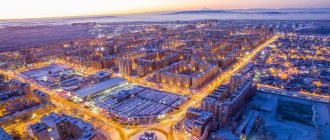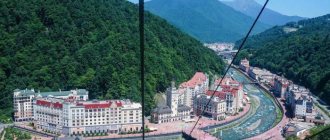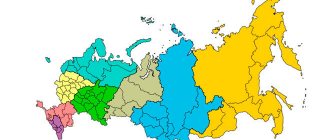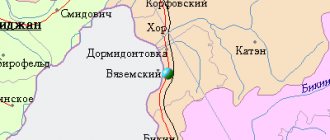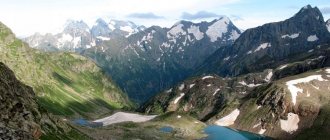RSS newsletter Characteristics of the Altai Territory
HomeSocio-economic development Characteristics of the Altai Territory
Brief description of the Altai region
Altai region
located in the southeast of Western Siberia, on the border of continental Asia, 3419 km from Moscow.
The territory of the region is 168 thousand square meters. km, in terms of area it ranks 21st in the Russian Federation and 6th in the Siberian Federal District. In the north, the region borders with the Novosibirsk region, in the east - with the Kemerovo region, the south-eastern border passes with the Altai Republic, in the south-west and west - the state border with the Republic of Kazakhstan, the length of which is 843.6 km. At the beginning of 2021, the population was 2.3 million inhabitants
(1.6% of the Russian population). A distinctive feature of the region is the high proportion of the rural population - 42.9% (in Russia - 25.3%).
10 urban districts in the region
and
59 municipal districts
.
The administrative center is Barnaul
.
Two types of landscapes predominate in the region: in the east – mountainous, in the west – flat. The Altai region is characterized by a rich flora and fauna. The region contains almost all natural zones of Russia: steppe and forest-steppe, taiga, mountains and rich river ecosystems.
Altai has huge reserves of various natural resources. Mineral resources are represented by deposits of polymetals, iron, table salt, soda, gypsum, brown coal and precious metals. The region is famous for its unique deposits of jasper, malachite, porphyry, marble, granite, building materials, mineral and drinking waters, and medicinal mud. The region is rich in forest resources. The forest fund makes up more than a quarter of the territory of the region and covers an area of 4433 thousand hectares. Of the 13,000 lakes, the largest is Kulundinskoye, with an area of 728 square meters. km. The largest rivers are the Ob, Biya, Katun, Alei and Charysh.
The economy of the Altai Territory is an established diversified complex. Industry, agriculture, and trade significantly predominate in the structure of the gross regional product
. These types of activities form about 50% of the total GRP.
The modern structure of the industrial complex of the region is characterized by a high share of manufacturing industries (over 80% of the volume of shipped goods), the leading of which are the production of food products, the production of engineering products (carriage, boiler, diesel, electrical equipment), coke production, as well as chemical production , pharmaceutical production, production of rubber and plastic products. At the same time, about 40% of the volume of the manufacturing sector of industrial production falls on the food and processing industries.
The Altai Territory is the largest producer of organic food in Russia: it ranks 1st in the country in terms of production volumes of flour, cereals, cheeses and cheese products, dry whey; 2nd place - in the production of butter, 3rd place - in the production of biologically active food additives, 4th place - in the production of pasta.
The agricultural complex is a large sector of the region's economy. The basis of the region's agriculture is the production of grain (including durum wheat), cereals and industrial crops, as well as livestock breeding. In terms of arable land area, the Altai Territory is the leader in the Russian Federation; the region accounts for a third of the arable land of the Siberian Federal District. The Altai Territory ranks 2nd in the Russian Federation in terms of the sown area of grain and leguminous crops. In 2021, the grain harvest in weight after processing amounted to 4.0 million tons
(12th place in Russia), the region retained its leading position in the country in terms of production volumes of spring wheat, buckwheat and oats.
The Altai Territory is the only region from the Urals to the Far East that grows sugar beets: in 2021, sugar beet production amounted to more than 1.2 million tons
. The region also gained a foothold in the top ten regions of the country in terms of production of sunflower oil seeds, took 4th place in Russia for rapeseed and 2nd place for oil flax.
In terms of the volume of production of livestock products among the constituent entities of the Russian Federation, the Altai Territory traditionally occupies a high position (4th place in milk production, 6th place in the production of high-quality beef). In terms of the number of cattle in all categories of farms, the region consistently ranks 4th.
The labor resources of the Altai Territory, trained by scientific and educational institutions of various profiles, are characterized by a high professional level and are able to satisfy the need of a developing economy for scientific research and highly qualified personnel for the implementation of innovative projects and the placement of technologically new production facilities.
The Altai Territory is located at the intersection of transcontinental transit freight and passenger flows, in close proximity to large raw materials and processing regions. Highways connecting Russia with Mongolia and Kazakhstan, a railway connecting Central Asia with the Trans-Siberian Railway, and international airlines pass through the territory of the Altai Territory. In terms of its availability of transport routes, the Altai Territory exceeds the average Russian and Central Siberian indicators. The favorable geographical location of the region and its high transport accessibility open up ample opportunities for establishing strong economic and trade ties at the interregional and international levels.
The recreational potential, combined with the favorable climate of the south of Western Siberia, and the rich historical and cultural heritage provide an opportunity for the development of various types of tourism and sports and entertainment recreation in the Altai Territory. Currently, the most popular among residents and guests of the region are medical and recreational, cultural and educational, children's, rural, event, and active types of tourism. Promising directions for the development of the tourism industry include environmental, ski, automobile, and medical types of tourism.
Geographically, the Altai Territory is divided into 2 enlarged tourist regions - Stepnoy Altai
and
Piedmont Altai
, each of which has its own unique characteristics. For Steppe Altai, these are numerous fresh and salt lakes with healing and healing properties. For Piedmont Altai, these are picturesque mountain landscapes, the presence of unique natural objects of display (the Lebediny reserve is one of 2 places in Russia where swans winter) and historical monuments (the archaeological monument of Denisova Cave), the development of a sanatorium-resort area (the only resort of the federal values in Siberia - the resort town of Belokurikha).
The region is not only a recognized health resort in Siberia, but also one of the largest resort centers in the Russian Federation, including 41 sanatorium and resort complexes
for 8.1 thousand places for one-time accommodation, including 7 children's institutions, in which
about 160 thousand people annually recover their health
. The region has valuable medicinal resources; mineral medicinal and medicinal table waters, sulfide silt mud, and medicinal plants are used.
The undisputed leader of the sanatorium and resort complex of the region is the resort town of Belokurikha
, which in recent years has been recognized as the best federal resort in Russia (there are 17 sanatorium and resort complexes located here, including 2 children's health resorts at the regional and federal levels). The development of Belokurikha as a center for health tourism is associated with the creation and development of the new site “Belokurikha Mountain”. This is a project to build a completely new resort, within which a range of modern health and entertainment services will be provided. During the implementation of the project, more than 3 thousand comfortable accommodations will be created, as well as the necessary engineering and transport infrastructure. Every year the resort city is visited by more than 200 thousand tourists and excursionists.
Also one of the leaders in the development of tourism infrastructure in the region is the Altai region, bordering the Katun River with the Altai Republic. Federal level projects are being implemented on its territory. A special economic zone of tourist and recreational type “Turquoise Katun” has been created here.
and
the Siberian Coin gambling zone
. According to expert estimates, more than 500 thousand tourists and excursionists visit the territory of the Altai region every year.
Also, with the involvement of federal budget funds (within the framework of the federal target program “Development of Domestic and Inbound Tourism”), such large tourist clusters as “Belokurikha”, “Barnaul - Mining” have been created in the Altai Territory. With the completion of this program, the development of these sites continued at the regional level, and the project to create a new resort "Belokurikha Mountain" received support at the federal level as part of the tourist cluster "Belokurikha - Altai Foothills" through the "Tourism" subprogram of the state program of the Russian Federation "Economic Development and innovative economy".
In order to develop active types of tourism and recreation in the region, with the involvement of funds from the regional budget, the development of the sports and tourism cluster “Tyagun”
.
2 million tourists visit the region annually
.
In 2021, the Altai Territory was among the 10 anchor tourist regions
, determined by the Federal Agency for Tourism to popularize holidays in Russia, and also entered the TOP 10 of the National Tourism Rating of Russian Regions, formed by the Center for Information Communications "Rating" and the magazine "Rest in Russia".
In 2021, the region was awarded leading awards in the tourism industry at the Russian level. Three projects of the Altai Territory became winners and prize-winners of the National Award in the field of event tourism Russian Event Awards 2021, six projects became winners of the federal competition aimed at developing domestic and inbound tourism (with a total amount of support of 13.5 million rubles).
Publication date: 03/31/2021
Climate in Altai
The climate of the Altai Territory belongs to the sharply continental type. The weather in the Altai Territory is very changeable; winds often blow here and precipitation occurs. In the flat part of the Altai Territory, summers are warm and winters are quite severe, but in June and August it often suddenly gets cold. In the low mountains and foothills, winters are less severe, but in summer the weather remains cool, and precipitation is frequent.
The climate of the Kulunda desert is even more severe: dust storms are a common occurrence here.
As a rule, they happen in May. Snowstorms and even snowstorms are observed here in November, February, and also in March. Authors: … …
Art of the Eastern Scythians
Based on the finds made in the Lazyryk mounds, one can judge the remarkable art of the Altai nomads. Wooden sculptures and bas-reliefs, geometric patterns, silhouettes and polychrome drawings - all techniques are often combined in one work. Among the images of animals, the most common are the horse, camel and deer. Of all animals, the Eastern Scythians gave a special place to the deer, because it was this animal, according to their ideas, that delivered souls to the afterlife.
Among the finds made in the mounds, there are few metal objects, but there is every reason to assume that there were much more of them and that they were varied: bronze figurines depicting animals and birds, cast, openwork and chased bas-reliefs made of copper, bronze, silver and gold . Craftsmen who worked with metal resorted to the same means of expression that they used in working with wood.
Of the samples coming from the southwest, unique fabrics and carpets are of exceptional interest because they are the oldest evidence of the existence of weaving and the art of carpet making in the Middle East. Altai nomads also borrowed some mythical motifs from Persia. One of them is a griffin, which later became a favorite subject of local art.
In the Altai Mountains, various archaeological monuments of the 6th-10th centuries dating back to the Turkic time were discovered, in which the connection between the Hunno-Sarmatian and Turkic periods of the history of Altai is clearly visible. During this period, the transition took place from the Indo-European inhabitants of Altai to the ancient Turks, the ancestors of modern Altaians, Turks and Mongols.
In the VI century. The Turkic tribes united into the powerful First Turkic Khaganate, which included in its possessions lands from the Caucasus and Crimea in the west to China in the east. In 572, the First Turkic Khaganate split into the Western Khaganate, with its center in Semirechye, and the Eastern Khaganate, with its center in modern Mongolia. In 682, the Second Turkic Khaganate was formed, which lasted until 744, until the appearance of the Uyghur Khaganate in the steppes of Central Asia, under whose rule the population of Altai came to be. After the fall of the Uyghur Khaganate in 840, the Altai tribes found themselves subordinate to the Yenisei Kyrgyz, the ancestors of the modern Khakass, and became part of the Kyrgyz Khaganate. Starting from the 6th century. the ancient Turks began to penetrate into the forest-steppe and forest zones of the Ob region. The Ugric-Samoyedic tribes who lived here were partially pushed to the north, while another part of them assimilated with the ancient Turks. In this way, the cultural differences that existed for many centuries between the population of the Altai mountain and steppe zone and the inhabitants of the Upper Ob were smoothed out. Turkic archaeological sites are the most diverse and well preserved in the Altai Mountains. Among them are mounds and memorial complexes, runic writings. Burials in ground pits with a southern orientation with accompanying burials of horses are typical. The dead were provided with ritual food, usually lamb.
“Stone women” (kezer tash) are also associated with the rich mounds of Turkic times and stone fences. This group of monuments dates back to the VI-IX centuries. More than 30 sculptures were discovered in Altai. Many were found along the Chuya tract, seven in the Kurai steppe. Some of the sculptures were taken by expeditions to museums in Tomsk, Gorno-Altaisk, Moscow (State Historical Museum) and St. Petersburg (Museum of Anthropology and Ethnography). Some women nevertheless remained in their places. Despite the meagerness of their visual means, the stone sculptures of the ancient Turks that have survived to this day are surprisingly individual and similar to the ancient people who lived in Altai more than a thousand years ago.
In addition, the Keser sculptures also had a purely practical meaning: thus, according to the animistic ideas of the Turks, the soul of the deceased could be enclosed in stone by a shaman; that is, the deceased himself seemed to be present at his wake. Often the stone figures of kesers - ancient warriors - are called stone women. Unlike the Polovtsian stone sculptures, with which they are often compared, the Altai figures never depict women, but are the embodiment of the image of an ancient warrior. The first stone sculptures of women in a conventional manner depict a person’s face, made in the upper part of the stele.
As a rule, this is a man with wide cheekbones, slanted eyes, a mustache and beard; Some sculptures depict earrings placed in the ears, and smooth hryvnias and necklaces on the neck. Later figures of Turkic warriors also depict ceremonial vestments with weapons (saber and dagger) on a belt decorated with figured plaques. The number and composition of belt plaques served as insignia of military distinction. Sometimes clothing is also depicted: hats, robes with lapels on the chest and wide sleeves with cuffs. In the warrior’s right hand there is a bowl or goblet, the left is lowered onto the hilt of the saber. The most expressive figures of the Altai Turks are known in the valleys of Uzuntal, Kurai, Karakol, Argut and White Anui.
More than 3,000 enclosures of Turkic times are known in the Altai Mountains. They are quadrangular structures made of stone slabs. These are the foundations of a temple or a wooden frame building in the form of a dwelling (similar structures are still erected over the graves of Altai and Kazakhs in South-Eastern Altai). Engraved drawings of animals and people are often found on the slabs of Altai fences. The space around the fences was lined with large boulders or small pebbles carefully fitted to each other. The fence represented the last refuge of the soul of the deceased. A larch tree was placed in the center, and a horse was sacrificed; the so-called “gailga” was installed - the skin of a sacrificial animal stretched over inclined stakes.
To the east from the fences with statues stretch small, vertically placed stones - balbas. This name in modern archeology was given to rows of low stone columns located next to fences. However, there is no unity among scientists regarding the interpretation of this term. Previously, stone sculptures were called balbals, and a phonetic simplification of the word explained why sculptures of warriors were often called women. Previously, all researchers were unanimous in the fact that the Turks placed stone pillars - balbals - at the memorial structures of their warriors according to the number of enemies killed by the buried person. But the large number of balbals (several dozen, sometimes hundreds) at the memorial complexes of the ancient Turkic aristocracy makes archaeologists doubt this version: it is difficult to imagine that the Turkic kagans could kill hundreds of enemy warriors during their lifetime. In recent years, there has been widespread speculation that the number of stones corresponds to the number of relatives who took part in the funeral.
It is possible that the stones are symbolic hitching posts - an integral part of any nomad’s home. The balbal hitching post was a kind of sign of the presence (attention) of a certain person to the deceased. In addition, here one can draw a parallel between the Altai balbals and the wooden hitching posts-serge, revered by the Buryats and Yakuts. Also belonging to the cultural layer of Turkic times are numerous petroglyphs and writings - rock paintings and elements of Turkic runic writing. Petroglyphs are made using the technique of dot knockout or graffiti, i.e. drawn drawing.
As a rule, the drawings depict animals, horsemen, battle scenes and hunting scenes, birds and snakes, and fantastic creatures. The runic inscriptions on the stones are made with signs of the Orkhon-Yenisei alphabet. Some Turkic settlements have been preserved in the Altai Mountains. Most of them were located on mountain slopes, in ravines or at the foot of the mountains, which made it possible in case of military danger to withdraw to a neighboring valley. The most famous Turkic settlement was excavated at the mouth of the Bolshoi Yaloman River. According to researchers, it was a significant and large city of the Turks. Chinese chronicles characterize the Turks as skilled metallurgists, supplying iron and blacksmith products to their neighbors.
Excursions and activities in Altai
Excursions in the Altai Territory are very diverse. These are various tourist routes, for example, visiting caves (the Denisova Cave and the 70-meter-high waterfall, the Tavda Caves, the karst arch in Tavda, as well as the Kek-Tash cave with beautiful stalactites and stalagmites are interesting).
In addition, in the Altai Territory, rafting on mountain rivers, hiking tours to the foot of Mount Belukha, ethnotours, trips to the Multinsky Lakes, motorcycle tours along the Chuya tract through the Altai Mountains, horseback riding, auto tours and much more are organized.
Another excursion that can be recommended to curious tourists is a visit to the Charysh caves. The remains of extinct animals were discovered here. Travelers will be able to see the bones of mammoths and bison, woolly rhinoceroses and fossil deer that have disappeared from the face of the earth.
Also, be sure to visit the Royal Mound: this is an archaeological memorial complex located along the banks of the Sentelek River, which dates back to the 5th century BC.
Here tourists will be able to admire 19 4.5-meter-high stelae that reach into the sky, as well as see the bypass and inner rings made of powerful slabs. Authors: … …, Alexander Gordiets (editor-in-chief)
Transport features of Altai
Altai transport : the main feature of the region is the almost complete absence of railway transport, but to this day the easiest way to get to Altai is by train.
The largest railway stations are located in Barnaul, Biysk and Novosibirsk.
There is also an airport in Altai, which is located in the city of Gorno-Altaisk. Tourists can arrive here by plane from Moscow, as well as from Krasnoyarsk and Novosibirsk. Flights are carried out by S7 air carrier.
There is also an airport in Barnaul; Aeroflot, Transaero, S7 and UTair fly here from Moscow.
The cities of the Altai Territory are connected by bus service. Minibuses run around the cities. There is a bus station in Barnaul, from where you can go to Biysk, Karakola, Gorno-Altaisk, Chemala, Katun and many other cities.
Of course, you can travel around the Altai Territory by car.
The most beautiful highway in the region is 52, it turns into the famous Chuysky tract. Authors: … …
